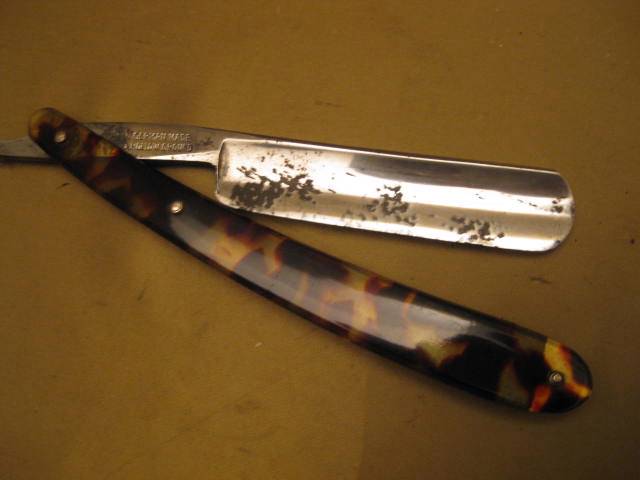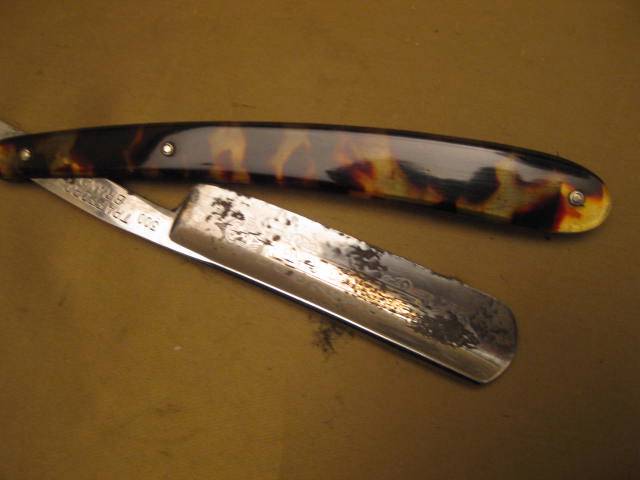Results 11 to 20 of 44
Thread: Scale rot example
Hybrid View
-
12-07-2013, 07:15 PM #1At this point in time...




- Join Date
- Jun 2007
- Location
- North Idaho Redoubt
- Posts
- 27,077
- Blog Entries
- 1
Thanked: 13249
Here is the thing, you are trying really hard to definitively say this is Cell Rot, which everyone is trying to tell you that although you may very well be right, there is just NO way to definitively say that from the 2 pics presented.. That is what everyone is trying to get across (at least that is my impression) we are not saying you are wrong we are simply saying that there isn't enough info presented to tell for sure
Without further info it is a distinct possibility that this is most likely Cell Rot, did you notice the wording I just used..
Now if that razor were in hand it would be a whole different story, regardless of whether it is cell rot or not the razor is in need of serious restoration if it will survive that is also not definitive from the pics
Last edited by gssixgun; 12-07-2013 at 07:18 PM.
-
12-07-2013, 07:38 PM #2Senior Member



- Join Date
- Apr 2008
- Location
- Essex, UK
- Posts
- 3,816
Thanked: 3164
I agree, it has to be assessed in-hand.
With mottled celluloid it is true that the steel under clear areas is more affected than under dark, opaque areas. This is usually because dark/opaque areas come from a different mix, usually containing a large amount of filler (usually powdered asbestos) to take the colouring and make a solid colour. That means this type has less acid releasing celluloid, so the marking on the steel is not as severe.
In this example the darker areas seem to contain just dye, so something else is happening. Either the razor has been kept in the light and the light celluloid has transmitted light, drying the vapour and concentrating it. However, it might just be water already on the blade in conjunction with a phenomenom akin to 'pattern staining' that you sometimes see on the walls of plastered/rendered buildings.
In this case the staining is caused by heat differentials. Warm areas encourage airfow wile cool areas allow the air to move slowly. Warm air can hold more moisture than cold air, so cooler areas get water deposited on them, and stain.
Or it could be a combination of both. If it is celluloid, then part of the breakdown process is the liberation of water vapour along with corrosive gas.
Regards,
Neil
-
The Following User Says Thank You to Neil Miller For This Useful Post:
pfries (12-07-2013)
-
12-08-2013, 08:31 AM #3Senior Member

- Join Date
- Jul 2013
- Location
- Liverpool, UK
- Posts
- 160
Thanked: 14
Yes, just like Brad Maggard's example.
-
12-07-2013, 08:19 PM #4Senior Member

- Join Date
- Jul 2013
- Location
- Liverpool, UK
- Posts
- 160
Thanked: 14
No, I'm not trying to do that at all - I happily agree you can't tell for sure without actual examination, as I have already said.
I'm just curious that so many people seem to think it's more likely to be just plain rust but don't have any ideas as to how simple rust would form in the same pattern as the scale colors (and I'm staggered that at least one person can't even see it!)
And I'm just trying to discuss it to see if anyone can offer any suggestions that might explain it - but if nobody can or wants to, I'll just shut up and go away.
Update: Apologies, I see Neil has offered some suggestions that might explain it - thanks. I just replied before I read to the end.
Further update: I also confess I'm still smarting from the sarcastic put-down I got - and it's not the first time on this forum. I apologise for not liking it, and now I really will go away.Last edited by Oscroft; 12-07-2013 at 08:23 PM.
-
12-07-2013, 08:42 PM #5Senior Member


- Join Date
- Jan 2011
- Location
- Roseville,Kali
- Posts
- 10,432
Thanked: 2027
No Need to go away,you had some supporting Evidence about the colors,I found that interesting.
Maybe it is cell rot, maybe not.
-
12-07-2013, 10:46 PM #6

Last edited by JimmyHAD; 12-07-2013 at 10:49 PM.
-
12-10-2013, 01:32 AM #7


- Join Date
- May 2005
- Location
- St. Louis, Missouri, United States
- Posts
- 8,454
- Blog Entries
- 2
Thanked: 4942
There have been some people who have agreed and some who have not. I see nothing wrong with this and question why it is so important that you seem to need the recognition for being correct here.
OK, I get it, you came here to pick a fight and then go back to your Hate Forum to proclaim your status and get some additional recognition as well as a heightened status for shaking the bushes over here. I notice the usual hate and agenda boys that participate over there on every thread like the one you started falling right into line. Too bad. If this thread was in your house, it would have already been deleted with all who disagreed with you banned and it's existence forgotten in a minute. It really would be nice to see the forums get along mutually, but I suspect that will never happen so long as Trolls and those who just come over to pick a fight here continue with the same nonsense.
We have so many great members here who participate in many of the forums and media venues out there and seem to have no problems co-existing. I really hate to see just a few people from one hate venue continue to come here and proclaim themselves professors of straight razors and proclaim that their opinions will either be excepted or we will be condemned negatively. People not only disagree with me and each other daily, but they find new ways of doing things and the new ways and new things really work and every one seems to learn something. We are always learning and I think that is the key more than any self recognition, self righteousness or any negative agenda for that mater. The goal of this place is to promote wetshaving and to help people become successful in all aspects of wet shaving and to pay if forward when ever possible. It is not here for any one to proclaim their righteousness.
So, I guess I better close this one now eh.......
Have fun.
Last edited by Lynn; 12-10-2013 at 01:42 AM.
-
The Following 9 Users Say Thank You to Lynn For This Useful Post:
Chevhead (12-10-2013), Geezer (12-10-2013), JimmyHAD (12-10-2013), Neil Miller (12-10-2013), randydance062449 (12-11-2013), ScottGoodman (12-10-2013), sharptonn (12-10-2013), SirStropalot (12-10-2013), zib (12-10-2013)
-
12-07-2013, 09:16 PM #8This is not my actual head.



- Join Date
- Nov 2009
- Location
- Middle of nowhere, Minnesota
- Posts
- 4,624
- Blog Entries
- 2
Thanked: 1371
I guess the bottom line for me is that if I had that razor and took the time to clean it up, those scales would not go back on it.
Strange women lying in ponds distributing swords is no basis for a system of government.
-
12-08-2013, 05:43 AM #9This is not my actual head.



- Join Date
- Nov 2009
- Location
- Middle of nowhere, Minnesota
- Posts
- 4,624
- Blog Entries
- 2
Thanked: 1371
I think from an Ebay standpoint, if I were looking for a razor and wanted to keep the scales, I'd pass on the one shown.
Strange women lying in ponds distributing swords is no basis for a system of government.


 58Likes
58Likes LinkBack URL
LinkBack URL About LinkBacks
About LinkBacks











